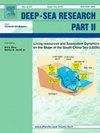On the sensitivity of Optimum Multiparameter Analysis: a California Current System case study
IF 3
3区 地球科学
Q2 OCEANOGRAPHY
Deep-sea Research Part Ii-topical Studies in Oceanography
Pub Date : 2025-06-01
DOI:10.1016/j.dsr2.2025.105498
引用次数: 0
Abstract
Eastern boundary upwelling systems, like the California Current System (CCS), represent a confluence and mixing of water masses whose variability and composition play a key role in modulating their high biological productivity and ecosystem variability. In the southern CCS, the relative contribution (i.e. proportion) and variability of its source water masses was quantified previously using an extended Optimum MultiParameter (eOMP) analysis, which is an inverse modeling technique that solves a set of linear mixing equations using quasi-conservative and non-conservative properties. However, there are several oceanographic decisions implicit in eOMP analysis that can generate uncertainties in the representation of the mixing and proportions of the source waters in a region. Here we quantify the sensitivity of these previous eOMP results in the southern CCS to varying oceanographic assumptions based on the uncertainty of the water mass properties, modified Redfield ratios, and alternate locations of the eastern tropical Pacific source waters. We show that the mean relative contributions of the main CCS source waters are more sensitive to the location of their selected source region (∼20–25 %) and the Redfield ratio (∼15–20 %) than to the uncertainty in the source water properties (∼2–5 %). Understanding the uncertainties of the eOMP assumptions benefits similar studies in other regions, especially in other eastern boundary upwelling systems (EBUS) where water masses characteristics and composition strongly impact the ecosystem.
最优多参数分析的敏感性:以加州电力系统为例
东部边界上升流系统,如加利福尼亚洋流系统(CCS),代表了水团的汇合和混合,其变异性和组成在调节其高生物生产力和生态系统变异性方面起着关键作用。在南部CCS,源水质量的相对贡献(即比例)和变率先前使用扩展的最优多参数(eOMP)分析进行了量化,eOMP是一种逆建模技术,利用准保守和非保守性质求解一组线性混合方程。但是,在eOMP分析中隐含着若干海洋学决定,这些决定可能在表示一个区域内源水的混合和比例方面产生不确定性。在这里,我们量化了这些之前在南部CCS的eOMP结果对不同海洋学假设的敏感性,这些假设基于水质量特性的不确定性、修正的Redfield比率和热带太平洋东部源水的替代位置。我们发现,主要CCS源水的平均相对贡献对其所选源区域的位置(~ 20 - 25%)和Redfield比率(~ 15 - 20%)比对源水性质的不确定性(~ 2 - 5%)更为敏感。了解eOMP假设的不确定性有助于在其他地区进行类似的研究,特别是在其他东部边界上升流系统(EBUS)中,其中水团特征和组成强烈影响生态系统。
本文章由计算机程序翻译,如有差异,请以英文原文为准。
求助全文
约1分钟内获得全文
求助全文
来源期刊
CiteScore
6.40
自引率
16.70%
发文量
115
审稿时长
3 months
期刊介绍:
Deep-Sea Research Part II: Topical Studies in Oceanography publishes topical issues from the many international and interdisciplinary projects which are undertaken in oceanography. Besides these special issues from projects, the journal publishes collections of papers presented at conferences. The special issues regularly have electronic annexes of non-text material (numerical data, images, images, video, etc.) which are published with the special issues in ScienceDirect. Deep-Sea Research Part II was split off as a separate journal devoted to topical issues in 1993. Its companion journal Deep-Sea Research Part I: Oceanographic Research Papers, publishes the regular research papers in this area.

 求助内容:
求助内容: 应助结果提醒方式:
应助结果提醒方式:


